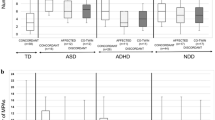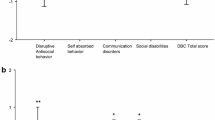Abstract
The recent literature concerning minor physical anomalies (MPA) and their relation to behavior is reviewed. Research seems to indicate that for males there is considerable consistency in the results but the finding with females is tenuous at best. It appears that a high number of MPA are evident in several pathological groups of boys, as compared with normal controls. In addition, there is a suggestion that MPA are correlated with severity of hyperactivity, IQ, and school achievement. Furthermore, there is also a relationship between a high number of MPA and obstetrical complications. The etiology of MPA and their utility in predicting pathological behavior is discussed.
Similar content being viewed by others
References
Bergin, A. B. (1971). The evaluation of therapeutic outcomes. In A. E. Bergin & S. L. Garfield (Eds.),Handbook of Psychotherapy and behavior change. New York: Wiley.
Burg, C., Hart, D., Quinn, P., & Rapoport, J. (1978). Newborn minor physical anomalies and prediction of infant behavior.Journal of Autism and Childhood Schizophrenia, 9, 427–439.
Burg, C., Rapoport, J. L., Bartley, L. S., Quinn, P. O., Timmins, P. (1980). Newborn minor physical anomalies problem behavior at age three.American Journal of Psychiatry, 137(7), 791–796.
Campbell, M., Geller, B., Small, A. M., Petti, T. A., & Ferris, S. H. (1978). Minor physical anomalies in young psychotic children.American Journal of Psychiatry, 135, 573–575.
Conners, C. K. (1969). A Teacher Rating Scale for use in drug studies with children.American Journal of Psychiatry, 126, 884–888.
Conners, C. K. (1970). Symptom patterns in hyperkinetic, neurotic, normal children.Children Development, 41, 667–672.
Durfee, K. E. (1974). Crooked ears and the bad boy syndrome: Asymmetry as an indicator of minimal brain dysfunction.Bulletin of the Menninger Clinic, 38(4), 305–316.
Firestone, P., Lewy, F., & Douglas, U. I. (1976). Hyperactivity and physical anomalies.Canadian Psychiatric Association Journal, 21, 23–26.
Firestone, P., Peters, S., Rivier, M., & Knights, R. M. (1978). Minor physical anomalies in hyperactive, retarded and normal children and their families.Journal of Child Psychology and Psychiatry, 19, 155–160.
Firestone, P., & Prabhu, A. (1983). Minor physical anomalies and obstetrical complications: Their relationship to hyperactive, psychoneurotic and normal children and their families.Journal of Abnormal Child Psychology, 11, 207–216.
Goldfarb, W., & Botstein, A. (1967).Physical stigmata in schizophrenic children. Unpublished manuscript, Henry Ittleson Center for Child Research, Brooklyn, New York.
Halverson, C. F., & Victor, J. B. (1976). Minor physical anomalies and problem behaviour in elementary school children.Child Development, 47, 281–285.
Halverson, C. F., & Waldrop, M. F. (1976). Relations between preschool activity and aspects of intellectual and social behavior.Developmental Psychology, 12, 107–112.
Jacklin, C., Maccoby, E. E., & Halverson, C. F. (1980). Minor physical anomalies and preschool behavior.Journal of Pediatric Psychology, 5(2) 199–205.
Lerer, R. J. (1977). Do hyperactive children tend to have abnormal palmar creases?Clinical Pediatrics, 16, 645–647.
Links, P. S. (1980). Minor physical anomalies in childhood autism. Part II. Their relationship to maternal age.Journal of Autism and Developmental Disorders, 10, 287–292.
Links, P. S., Stockwell, M., Abichanandi, F., & Simeon, J. (1980). Minor physical anomalies in childhood autism. Part 1. Their relationship to pre- and perinatal complications.Journal of Autism and Developmental Disorders, 10, 273–285.
Marden, P. M., Smith, D. W., & McDonald, M. J. (1964). Congenital anomalies in the newborn infant, including minor variations.Journal of Pediatrics, 64, 357–371.
Nichols, P. (1967, March).Minimal brain dysfunction: Associations with perinatal complications. Paper presented at the meeting of the Society for Research in Child Development, New Orleans.
O'Donnell, J. P., O'Neill, S., & Staley, A. (1979). Congenital correlates of distractibility.Journal of Abnormal Child Psychology, 7(4), 465–470.
O'Donnell, J. P., & Van Tuinan, M. (1979). Behavior problems of preschool children: Dimensions and congenital correlates.Journal of Abnormal Child Psychology, 7(1), 61–75.
Pope, L. (1977).Motor activity in brain-injured children (1977). Brooklyn, New York: Psychiatry Services, Coney Island Hospital.
Quinn, P. O., & Rapoport, J. L. (1974). Minor physical anomalies and neurological status in hyperactive boys.Pediatrics, 53, 742–747.
Quinn, P. O., Renfield, M., Burg, C., & Rapoport, J. L. (1977). Minor physical anomalies: A newborn screening and 1 year follow-up.Journal of the American Academy of Child Psychiatry, 16, 662–669.
Rapoport, J. L., Pandoni, C., & Renfield, M., Lake, C. R., & Ziegler, M. G. (1977). Newborn dopamine-B-hydroxylase, minor physical anomalies and infant temperament.American Journal of Psychiatry, 136, 676–679.
Rapoport, J. L., & Quinn, P. (1975). Minor physical anomalies (stigmata) and early developmental deviation: A major biological subgroup of “hyperactive children.”International Journal of Mental Health, 4, 29–44.
Rapoport, J. L., Quinn, P. O., & Lamprecht, F. (1974). Minor physical anomalies and plasma dopamine-beta-hydroxylase activity in hyperactive boys.American Journal of Psychiatry, 131(4), 386–390.
Rosenberg, J. B., & Weller, G. M. (1973). Minor physical anomalies and academic performance in young school-children.Developmental Medicine and Child Neurology, 15, 131–135.
Smith, D. W. (1976).Recognizable patterns of human malformation. Philadelphia: Saunders.
Smith, D. W., & Bostian, K. E. (1964). Congenital anomalies associated with idiopathic mental retardation.Journal of Pediatrics, 65, 189–196.
Steg, J. P., & Rapoport, J. L. (1975). Minor physical anomalies in normal, neurotic, learning-disabled, and severely disturbed children.Journal of Autism and Childhood Schizophrenia, 5, 399–307.
Stevens, T. M., Kupst, M. J., Suran, B. G., & Schulman, J. L. (1978). Activity level: A comparison between actometer scores and observer ratings.Journal of Abnormal Child Psychology, 6, 163–173.
Stott, D. J. (1973). Follow-up study from birth of the effects of prenatal stresses.Developmental Medicine and Child Neurology, 15, 770–787.
Victor, J. B., & Halverson, C. F., Jr. (1976). Behavior problems in elementary school-children: A follow-up study.Journal of Abnormal Child Psychology, 4, 17–29.
Von Hilsheimer, G., & Kurko, U. (1979). Minor physical anomalies in exceptional childrenJournal of Learning Disabilities, 12, 38–45.
Waldrop, M. F., Bell, R. O., & Goering, J. D. (1976). Minor physical anomalies and inhibited behavior in elementary school girls.Journal of Child Psychology and Psychiatry, 17, 113–122.
Waldrop, M. F., Bell, R. Q., McLaughlin, B., & Halverson, C. F., Jr. (1978). Newborn minor physical anomalies predict short attention span, peer aggression and impulsivity at age 3.Science, 199, 563–565.
Waldrop, M. F., & Goering, J. D. (1971). Hyperactivity and minor physical anomalies in elementary school children.American Journal of Orthopsychiatry, 41, 602–607.
Waldrop, M. F., & Halverson, C. F. (1971). Minor physical anomalies and hyperactive behavior in young children. In: J. Hellmath (Ed.),Exceptional Infant,2, 343–380.
Waldrop, M. F., & Halverson, C. F. (1982). Minor physical anomalies: Their incidence and relation to behavior in a normal and a deviant sample. In R. C. Smart & M. S. Smart (Eds.),Readings in child development and relationships. New York: Macmillan.
Waldrop, M. F., Pederson, F. A., & Bell, R. Q. (1968). Minor physical anomalies and behavior in preschool children.Child Development, 39, 391–400.
Walker, H. A. (1977). Incidence of minor physical anomalies in autism.Journal of Autism and Childhood Schizophrenia, 7, 165–176.
Wender, P. (1971).Minimal brain dysfunction in children. New York: Wiley.
Werner, E., & Smith, R. (1977).Kauai's children come of age. Honolulu: University of Hawaii Press.
Author information
Authors and Affiliations
Rights and permissions
About this article
Cite this article
Firestone, P., Peters, S. Minor physical anomalies and behavior in children: A review. J Autism Dev Disord 13, 411–425 (1983). https://doi.org/10.1007/BF01531589
Issue Date:
DOI: https://doi.org/10.1007/BF01531589




